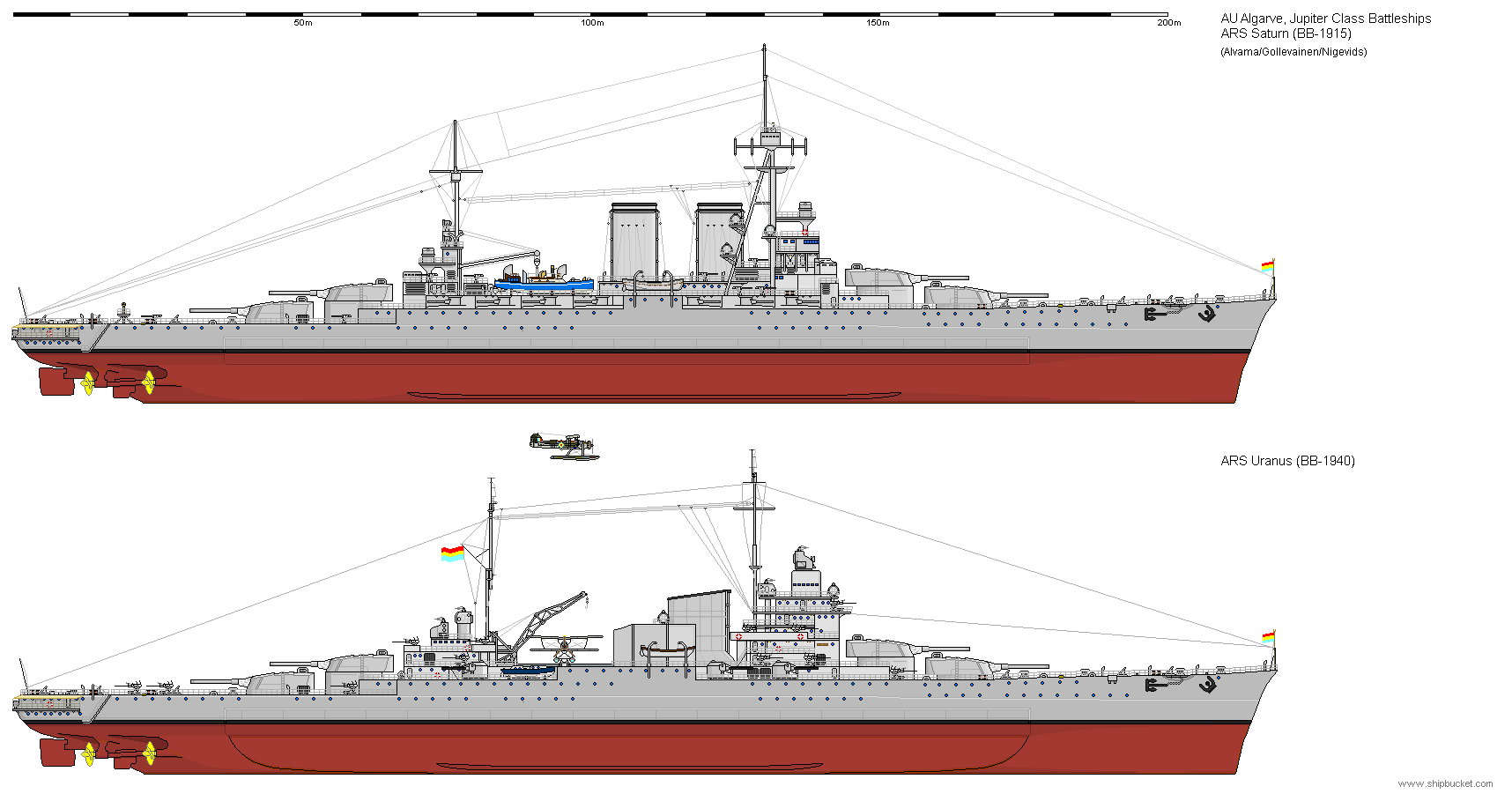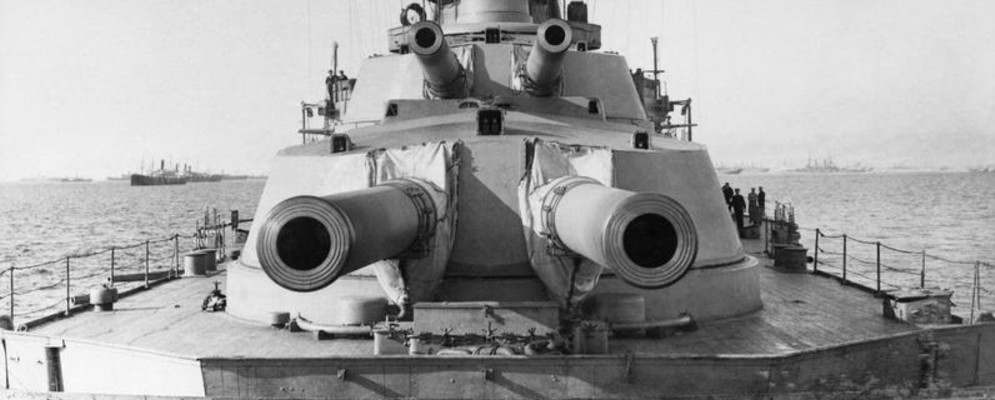The Jupiter class were built concurrently with the British Queen Elizabeth class. Each member of the Jupiter Class took almost a year longer each to build than the QE's. The first two were laid down in 1911 and completed for service in late 1915. The second pair were laid down in 1912 and did not complete till early 1917, as other priorities put the two battleships completion dates further and further out.
Having built six of the Newport Class, there was no thought given to building battleships with the 13.5" guns the British built twelve of (and completed the Erin from an export order for number 13). Algarve could not hope to keep up with the major powers building rates, but they could build quality ships with the best available technology aboard.
The Jupiter class were built around the twin 15" gun system, with four twin turrets on each ship. The ships were to be hybrid battleship/battlecruiser, with both good armour protection and a reasonable turn of speed. These were big ships, and for a short period were the biggest in the world when completed.

The British were fully aware of the Jupiter class ships and had a request in for the first pair to be sent to Britain to enhance the advantage the Allied fleet had over the High Seas Fleet. On arrival at Scapa Flow, the two ships were seconded to the 5th Battle squadron, joining the 5 ships of the Queen Elizabeth class. The Queen Elizabeth Class, because of its speed, had been pushed hard as the 'fast' wing of the Grand Fleet. Admiral Jellicoe had been loathe to allow them too much time in port for general maintenance, after all, the ships were brand new. The extra two ships allowed for the 5th BS to be able to set up a decent maintenance schedule. Unfortunately for Saturn, it was docked with condenser problems while the Queen Elizabeth was in for maintenance and both ships missed the Battle of Jutland. The Jupiter being a 'foreigner' and the fast ship in the squadron was assigned tail end Charlie position. Last in the line at Windy Corner proved that the Algarvian builders, had built well. Even though the Jupiter turned a bit earlier than it should have per order (and as Warspite had) the Germans could just blast away into a small area of sea and were bound to hit something. Jupiter took a dozen 11" and 12" hits, none of which caused any major damage, the worst being the hit on X turret which destroyed the communications circuits and for the rest of the battle X turret had to be fired manually when the commander heard the other turrets firing. During the charge of Admiral Hippers Scout squadron, the Jupiter was allocated the brand new battlecruiser Yorck as its target. This is where the accuracy of the 15" gun, penetration and the weight of shell, made havoc on the German ships. Giving back the dozen hits Jupiter had received earlier, the Yorck was last seen with major fires and flooding aboard and in company with the Lutzow was unable to make port and had to be scuttled by the accompanying light forces. That was the highlight of the Jupiter classes ships during World War One. The Neptune and Uranus joined the Grand Fleet in 1917 and the Neptune had to have its call sign altered to Algarvia as there was already a British battleship named Neptune with the Grand Fleet. 1917-18 and the four ships of the Jupiter class were with the Grand Fleet for its sorties, but no further contact with German forces were to be had.
1919 and the four Jupiter class ships return to Algarve and the peace and prosperity they had earned with their service against the evil Central Powers. The ships went through many little upgrades during the Inter-War period till returning from King George the V's silver jubilee review (July 1935) at Spithead in 1936 when first Jupiter, and then the other three in 1937-39, were taken in hand for rebuilding. The hulls were stripped between B and X turret, with a new propulsion system being fitted (120,00shp replacing the old 100,000shp system which with all the added weight kept the speed at 28 knots), new 5.5" armoured deck, new secondary and tertiary dual purpose guns, new superstructure, new aircraft handling facilities. The four ships were almost unrecognisable from their original silhouettes.
1939 and the outbreak of war found the Jupiter and Uranus ready for sea having finished their rebuilds, while the Saturn was due to finish its rebuild in December 1939 and would be available for service early in 1940. Neptune's rebuild was put on a priority and it was finished in June 1940 (instead of the original November finish date).
I will finish here for the moment as I have not fleshed out all of the Algarves forces. I am still considering how much naval aviation and carriers will appear. How many and what type of cruisers etc.
As completed 1915-17
Displacement: 32,000 tons standard, 35,500 tons full load.
Dimensions: 717 x 92 x 28 feet.
Machinery: 4 shaft, turbines, 100,000shp
Speed: 28 knots
Endurance: 8,000 miles at 12 knots.
Armour: 12" belt, 3" deck, 12/8/5" turrets
Armament:
8 x 15" (4x2)
14 x 6" (14x1)
16 x 4" (16x1)
Crew: 1250

Twin 15" turrets from bow.
As rebuilt 1938-40.
Displacement: 34,000 tons standard, 38,500 tons full load
Dimensions: 717 x 100 (over bulges) x 28 feet.
Machinery: 4 shaft, geared turbines, 120,000shp
Speed: 28 knots.
Endurance: 10,000 miles at 15 knots
Armour: 12" belt, 5.5" deck, 12/8/5" turrets
Armament:
8 x 15" (4x2)
12 x 4.5" (6x2)
46 x 40mm (23x2)
Aircraft: 3
Crew: 1400 as flagship.
